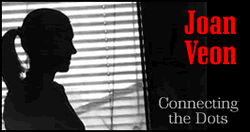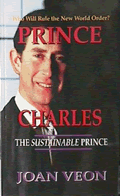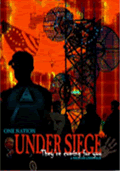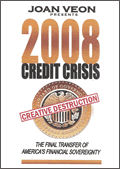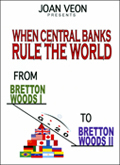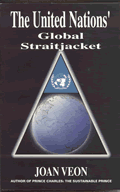THE FINAL PLUCKING OF AMERICA’S FINANCIAL AND ECONOMIC SOVEREIGNTY
By Joan Veon
April 13, 2009
NewsWithViews.com
Believe as you will about the 2008 Credit Crisis but if you fail to recognize that the final pieces of America’s financial and economic sovereignty are being transferred in the name of finding a global solution to the crisis, then you will have believed those who intend to steal your assets next, as well as your freedom.
How could America’s financial sovereignty be plucked from her both at the domestic and international levels? It is not because of a five or even twenty-five year plan but one that may be hundreds of years old. This plan, I’m sure, did not happen all at once but took time to evolve. It is a diabolically brilliant strategy in its scheming. In order to understand, we need to review how the credit crisis will lead to the total transfer of America’s sovereignty.
[Read "The Coming Battle" published in 1899, written by a man born before the civil war, predicting a battle between the people and the moneypower for freedom]
First came the rise of a novel idea whereby the government would borrow from a private corporation, and pay a perpetual interest. The private corporation, known as a central bank, got its roots in 1688 from the Swedish, and then went to the Dutch and then the British. The core of the idea was for governments to borrow indefinitely without having to pay down the principal. When the newly founded colonies broke from the British, it was Alexander Hamilton who convinced George Washington that a central bank would be good for America, also. Years later, in 1833, President Andrew Jackson closed the Second National Bank (America’s central bank) routing out the power of its foreign investors and returning our government to sound money. It was not until 1913 that a central bank would be reestablished in America transferring the power to coin money from Congress to the Federal Reserve.
Not without its own amount of chicanery and deceit did the Federal Reserve Bank come to pass. Other central banks were created as well. No one really knows who owns the Federal Reserve or the other central banks of the world. However, thanks to Prince Andrew’s series of documentaries about his forefathers, we now have proof that King William was the largest investor, £10,000, in the Bank of England in 1694. Might it be presumptuous to consider that if the British royal family invested in the Bank of England, they have probably invested in many other central banks since then to increase their wealth?
The Federal Reserve is not federal and it has no reserves. Money is printed on demand to lend to the American government. The Feds maintain their rights to charge us interest on the newly printed Federal Reserve Notes.
Secondly, we have to understand that all the barriers between the countries of the world have fallen except one; the regulatory barrier. In 1944, the economic and financial barriers between countries fell with the establishment of the World Bank and the International Monetary Fund. The political barriers fell with the creation of the United Nations in 1945; the trade barriers were removed in 1944 with the creation of the World Trade Organization; the legal barriers came down with the creation of the International Criminal Court in 1998; the military and intelligence barriers fell on September 11, 2001 with the attack on the World Trade Center in NYC. We are connected just as Presidents Clinton, Bush, and Obama have said. It should be noted that each of the global institutions have been busy setting up an infrastructure of their own since their respective inceptions. Please visit their websites.
Thirdly, to integrate the world from a regulatory standpoint does not make sense if there was no reason, to. The 1994 United Nations Development Programme Report explains all of the missing pieces of world government, which include an Economic Security Council, a World Central Bank, new credit facilities for the World Bank, increased Special Drawing Rights for the IMF, and a World Anti-Monopoly Authority. They specifically state: “It will probably take some time and probably some international financial crisis—before a full-scale World Central Bank can be created” (p.84). The last three were created at the G20 meeting.
Fourthly, we need to understand that the Treasury Blueprint for a Modernized Financial Regulatory System introduced by former Treasury Secretary Hank Paulson in March, 2007, calls for the complete shift of America’s financial and economic national sovereignty to the care and oversight of the Federal Reserve, independent of Congress. The Blueprint, when issued, received the approval of then New York Federal Reserve President Timothy Geithner, now our imminent treasury secretary. Has Obama changed the Blueprint? No, it is just tweaked here and there. The Blueprint calls for a new Federal Bank Charter which would put under Federal Reserve control financial institutions that are currently not regulated by them: savings and loans, credit unions, state chartered banks, and credit unions; it would provide for the insurance industry currently regulated on a state by state basis to be also put under federal control with Federal Reserve oversight; and it calls for the mortgage industry, which has not had any oversight, to be put under Federal Reserve oversight. There are calls for the Federal Reserve to have oversight over the entire Payment and Settlement system of Wall Street and for the Fed to act as “Market Stability Regulator.”
While there were concerted steps that helped to create the credit crisis, i.e.: Clinton’s Community Reinvestment Act of 1994, the repeal of the Glass-Steagall Act in 1999, and 45 year low interest rates as a result of 9/11 in 2001. All of these were major steps to create the “right circumstances” to transfer control over America’s financial and economic wealth.
Fifthly, in October 2008 Congress gave a blank check to Hank Paulson to use powers and money that Congress appropriated to help fix the problem. Paulson used these powers to show Congress who he was and what he was going to do. His first act was to nationalize nine inside banks with TARP money, instead of using it to buy toxic mortgages. Congress is now at the mercy of the treasury secretary, without power to stop their spending. Sadly, while the treasury secretary is a change agent for the Federal Reserve, Congress appears to be so shocked and mesmerized by the entire crisis, that they “want it fixed now at any cost.”
All of the above now brings us to the Group of Twenty meeting. There is no way they could have accomplished what they did in one day because of the complexity, the many facets and players at the international level and the various agendas. Instead, the outcome was preplanned and again I refer to the 1994 Human Development Report mentioned above. It is hard for anyone to understand and follow the implications and nuances unless they are extremely familiar with the international level and the activities of the last 12-16 years, and history going back one hundred years.
The G20 gave increasing powers and teeth to the Financial Stability Forum and changed its name to the Financial Stability Board. Established in 1999, its purpose was to monitor and bring together the G7 regulatory authorities. In a 2001 interview with Managing Director Svein Andressen, he told me, “there was no guarantee that it [the FSF] is going to protect the system, but the efforts go in this direction.” Because he was right, they have now been restructured. Did he know in advance how right he would be?
The Financial Stability Board will not be just a meeting of representatives from the G7 countries, which would include the Central Bank governor, the treasury secretary and representatives from regulatory agencies , but it will now have its own structure with a steering committee and plenary. It will work with the International Monetary Fund on Early Warning exercises and it will be expanded to the G20 countries plus Spain, and the European Commission. Its goal will be to harmonize changes in national regulatory structures—risk, market integrity, consumer protection, infrastructure, accounting and auditing, to conform to a global structure. Perhaps we can look upon them as some type of “Global Security and Exchange Commission.”
In other words, the “teeth” are being added to the international level: the Financial Stability Board, the International Monetary Fund, and the World Bank. Countries will now be ACCOUNTABLE and there will be repercussions if they are not. This constitutes another level in the transfer of national sovereignty. As the international level takes on more power, more funding in the form of Special Drawing Rights, new credit facilities, and a higher level of dues by every member country, the national level is reduced in power to the point where the federal level will basically be reduced to a state because the international level will take on the federal powers being transferred to them.
|
Subscribe to the NewsWithViews Daily News Alerts! |
America is being plucked from inside, via the credit crisis, at the federal level as our Congress agrees to transfer more power to the Federal Reserve and then at the international level where our Congress will be challenged to agree to what Obama promised in London. In short, visitors who go to Washington D.C. to see the seat of our country’s power should visit the Federal Reserve Building for that is where the real power resides.
� 2009 Joan Veon - All Rights Reserved
Sign
Up For Free E-Mail Alerts
E-Mails are used strictly
for NWVs alerts, not for sale
 Order
Joan Veon's book;
Order
Joan Veon's book;
"The
United Nations'
Global Straitjacket"
Joan Veon is a businesswoman and international reporter, who has covered over 100 Global meetings around the world since 1994. Please visit her website: www.womensgroup.org. To get a copy of her WTO report, send $10.00 to The Women's International Media Group, Inc. P. O. Box 77, Middletown, MD 21769. For an information packet, please call 301-371-0541
E-Mail: t7w7g7@aol.com
Website: www.womensgroup.org

